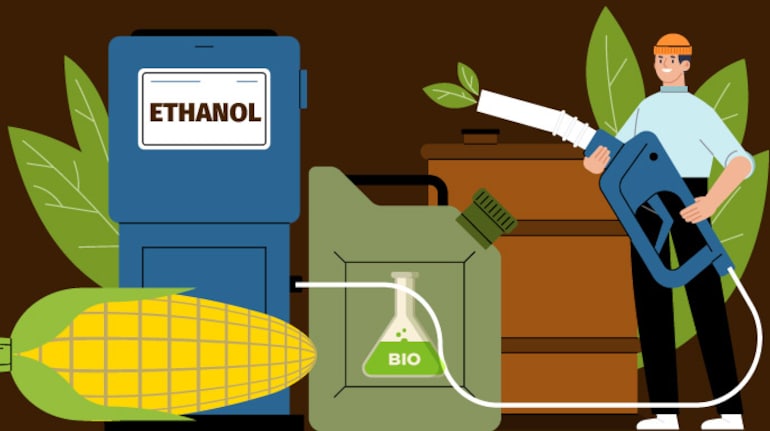ETHANOL

· The Ministry of Consumer Affairs, Food, and Public Distribution issued a directive to restrict the production of ethanol from sugarcane juice and syrup, an essential component of Ethanol Blended Petrol (EBP).
· The Indian government has carried out rigid measures to sustain homegrown sugar accessibility. At first, it forced a restriction on sugar trades.
What is Ethanol Mixing?
Ethanol:
· It is one of the primary Biofuels, which is normally delivered by the maturation of sugars by yeasts or through petrochemical cycles like ethylene hydration.
Ethanol is 99.9% unadulterated liquor that can be mixed with petroleum.
Ethanol Mixing Project (EBP):
· It aims to cut carbon emissions, increase farmers' incomes, and lessen the country's reliance on crude oil imports.
· The Public authority of India has progressed the objective for 20% ethanol mixing in petroleum (likewise called E20) to 2025 from 2030.
· The average amount of ethanol mixed with gasoline in India has increased from 1.6% in 2013-2014 to 11.8% in 2022-23.
Why has the government prevented sugar from being diverted to the production of ethanol?
Concerns About a Lack of Sugar:
· There are worries about a possible lack of sugar production.
· The transition to limit the redirection of sugarcane juice or syrup for ethanol creation is pointed toward tending to this expected lack.
Putting food ahead of fuel:
· The decision shows that food production (sugar) is more important than fuel production (ethanol).
· By underlining the development of sugar, a basic item in India, the public authority lines up with the need of guaranteeing Food Security and accessibility for purchasers.
Overseeing Supply-Request Elements:
· The sugar market's delicate equilibrium between supply and demand is being attempted to be managed by the government. It hopes to stabilize sugar availability and possibly reduce market price volatility by limiting diversion for ethanol production.
What Effects Will This Action Have?
Effect on the Production of Ethanol:
· This decision reduces the volume of ethanol produced from this high-value feedstock, which affects approximately 28% of total ethanol production.
· Sugar mills' earnings are expected to be impacted by the prohibition on using sugarcane juice or syrup for ethanol production, given that these feedstocks are more expensive than others.
Obstacles for Ethanol Blending Companies:
The public authority plans to raise the ethanol fuel-mixing objective from 12% to 15% in 2023-24 and has set an objective of accomplishing 20% ethanol mixing in petroleum by 2025-26.
· However, meeting these goals may become more difficult given the restriction on the use of sugarcane syrup and juice for the production of ethanol.
What other sources of ethanol production are there?
· Grains: Starch in cereal grains like wheat, barley, and corn (maize) can be fermented into sugars that can be used to make ethanol.
· Cellulosic Biomass: Agrarian buildups (corn stover, wheat straw), ranger service deposits, committed energy crops (switchgrass, miscanthus), and metropolitan strong waste contain cellulose and hemicellulose that can be separated into sugars for ethanol maturation.
· Rice: Excess rice, including broken or harmed grains, can likewise act as a hotspot for ethanol creation. The starch content in rice can be changed over into sugars for aging.
Leafy foods: Grapes and potatoes, two examples of high-sugar fruits and vegetables, can be used to make ethanol.